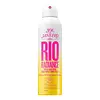What's inside
What's inside
 Key Ingredients
Key Ingredients

 Benefits
Benefits

 Concerns
Concerns

 Ingredients Side-by-side
Ingredients Side-by-side

Butyl Methoxydibenzoylmethane 3%
UV AbsorberEthylhexyl Salicylate 5%
UV AbsorberOctocrylene 9%
UV AbsorberAcrylates/Octylacrylamide Copolymer
Alcohol Denat.
AntimicrobialBisabolol
MaskingButyloctyl Salicylate
Skin ConditioningCapryloyl Glycerin/Sebacic Acid Copolymer
Skin ConditioningCocos Nucifera Water
MaskingDiheptyl Succinate
EmollientEthyl Ferulate
AntioxidantEthylhexyl Methoxycrylene
Skin ConditioningEugenia Uniflora Fruit Extract
AstringentLeuconostoc/Radish Root Ferment Filtrate
AntimicrobialNiacinamide
SmoothingParfum
MaskingPolyester-8
Skin ConditioningPongamia Pinnata Seed Extract
Skin ConditioningPotassium Sorbate
PreservativeSodium Benzoate
MaskingBenzyl Salicylate
PerfumingCitronellol
PerfumingLimonene
PerfumingButyl Methoxydibenzoylmethane 3%, Ethylhexyl Salicylate 5%, Octocrylene 9%, Acrylates/Octylacrylamide Copolymer, Alcohol Denat., Bisabolol, Butyloctyl Salicylate, Capryloyl Glycerin/Sebacic Acid Copolymer, Cocos Nucifera Water, Diheptyl Succinate, Ethyl Ferulate, Ethylhexyl Methoxycrylene, Eugenia Uniflora Fruit Extract, Leuconostoc/Radish Root Ferment Filtrate, Niacinamide, Parfum, Polyester-8, Pongamia Pinnata Seed Extract, Potassium Sorbate, Sodium Benzoate, Benzyl Salicylate, Citronellol, Limonene
Dibutyl Adipate
EmollientWater
Skin ConditioningDiethylamino Hydroxybenzoyl Hexyl Benzoate
UV FilterDicaprylyl Carbonate
EmollientPropanediol
SolventEthylhexyl Triazone
UV AbsorberMethylpropanediol
SolventBis-Ethylhexyloxyphenol Methoxyphenyl Triazine
Skin ConditioningPhenylbenzimidazole Sulfonic Acid
UV AbsorberArginine
MaskingLupinus Albus Seed Oil
Skin ConditioningBenzotriazolyl Dodecyl P-Cresol
UV AbsorberSodium Chloride
MaskingPalmitoyl Grape Seed Extract
Skin ConditioningGlycerin
HumectantCaprylyl Glycol
EmollientNiacinamide
SmoothingPhenylpropanol
MaskingO-Cymen-5-Ol
AntimicrobialTocopheryl Acetate
AntioxidantPicea Abies Wood Extract
Linalool
PerfumingHelianthus Annuus Seed Oil
EmollientHexyl Cinnamal
PerfumingTocopherol
AntioxidantParfum
MaskingGeraniol
PerfumingCitronellol
PerfumingDibutyl Adipate, Water, Diethylamino Hydroxybenzoyl Hexyl Benzoate, Dicaprylyl Carbonate, Propanediol, Ethylhexyl Triazone, Methylpropanediol, Bis-Ethylhexyloxyphenol Methoxyphenyl Triazine, Phenylbenzimidazole Sulfonic Acid, Arginine, Lupinus Albus Seed Oil, Benzotriazolyl Dodecyl P-Cresol, Sodium Chloride, Palmitoyl Grape Seed Extract, Glycerin, Caprylyl Glycol, Niacinamide, Phenylpropanol, O-Cymen-5-Ol, Tocopheryl Acetate, Picea Abies Wood Extract, Linalool, Helianthus Annuus Seed Oil, Hexyl Cinnamal, Tocopherol, Parfum, Geraniol, Citronellol
Ingredients Explained
These ingredients are found in both products.
Ingredients higher up in an ingredient list are typically present in a larger amount.
Citronellol is used to add fragrance/parfum to a product. It is often derived from plants such as roses. In fact, it can be found in many essential oils including geranium, lavender, neroli, and more. The scent of Citronellol is often described as "fresh, grassy, and citrus-like".
Since the Citronellol molecule is already unstable, Citronellol becomes irritating on the skin when exposed to air.
Citronellol is a modified terpene. Terpenes are unsaturated hydrocarbons found in plants. They make up the primary part of essential oils.
Citronellol is not able to be absorbed into deeper layers of the skin. It has low permeability,
Citronellol is also a natural insect repellent.
Learn more about CitronellolNiacinamide is a multitasking form of vitamin B3 that strengthens the skin barrier, reduces pores and dark spots, regulates oil, and improves signs of aging.
And the best part? It's gentle and well-tolerated by most skin types, including sensitive and reactive skin.
You might have heard of "niacin flush", or the reddening of skin that causes itchiness. Niacinamide has not been found to cause this.
In very rare cases, some individuals may not be able to tolerate niacinamide at all or experience an allergic reaction to it.
If you are experiencing flaking, irritation, and dryness with this ingredient, be sure to double check all your products as this ingredient can be found in all categories of skincare.
When incorporating niacinamide into your routine, look out for concentration amounts. Typically, 5% niacinamide provides benefits such as fading dark spots. However, if you have sensitive skin, it is better to begin with a smaller concentration.
When you apply niacinamide to your skin, your body converts it into nicotinamide adenine dinucleotide (NAD). NAD is an essential coenzyme that is already found in your cells as "fuel" and powers countless biological processes.
In your skin, NAD helps repair cell damage, produce new healthy cells, support collagen production, strengthen the skin barrier, and fight environmental stressors (like UV and pollution).
Our natural NAD levels start to decline with age, leading to slower skin repair, visible aging, and a weaker skin barrier. By providing your skin niacinamide, you're recharging your skin's NAD levels. This leads to stronger, healthier, and younger looking skin.
Another name for vitamin B3 is nicotinamide. This vitamin is water-soluble and our bodies don't store it. We obtain Vitamin B3 from either food or skincare. Meat, fish, wheat, yeast, and leafy greens contain vitamin B3.
The type of niacinamide used in skincare is synthetically created.
Learn more about NiacinamideParfum is a catch-all term for an ingredient or more that is used to give a scent to products.
Also called "fragrance", this ingredient can be a blend of hundreds of chemicals or plant oils. This means every product with "fragrance" or "parfum" in the ingredients list is a different mixture.
For instance, Habanolide is a proprietary trade name for a specific aroma chemical. When used as a fragrance ingredient in cosmetics, most aroma chemicals fall under the broad labeling category of “FRAGRANCE” or “PARFUM” according to EU and US regulations.
The term 'parfum' or 'fragrance' is not regulated in many countries. In many cases, it is up to the brand to define this term.
For instance, many brands choose to label themselves as "fragrance-free" because they are not using synthetic fragrances. However, their products may still contain ingredients such as essential oils that are considered a fragrance by INCI standards.
One example is Calendula flower extract. Calendula is an essential oil that still imparts a scent or 'fragrance'.
Depending on the blend, the ingredients in the mixture can cause allergies and sensitivities on the skin. Some ingredients that are known EU allergens include linalool and citronellol.
Parfum can also be used to mask or cover an unpleasant scent.
The bottom line is: not all fragrances/parfum/ingredients are created equally. If you are worried about fragrances, we recommend taking a closer look at an ingredient. And of course, we always recommend speaking with a professional.
Learn more about Parfum